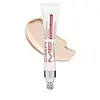What's inside
What's inside
 Key Ingredients
Key Ingredients

 Benefits
Benefits

 Concerns
Concerns

 Ingredients Side-by-side
Ingredients Side-by-side

Water
Skin ConditioningC12-15 Alkyl Benzoate
AntimicrobialHydrogenated Polyisobutene
EmollientGlycerin
HumectantAcrylates Copolymer
Pvp
Emulsion StabilisingSilica
AbrasiveCetyl Alcohol
EmollientGlyceryl Stearate
EmollientPEG-100 Stearate
PEG-40 Stearate
EmulsifyingDimethicone
EmollientHydrolyzed Sesame Protein Pg-Propyl Methylsilanediol
Skin ConditioningHydrolyzed Wheat Protein
Skin ConditioningSoy Protein Phthalate
EmollientPolyacrylamide
C13-14 Isoparaffin
EmollientLaureth-7
EmulsifyingSteareth-20
CleansingN-Hydroxysuccinimide
Skin ConditioningChrysin
Skin ConditioningPalmitoyl Tripeptide-1
Skin ConditioningPalmitoyl Tetrapeptide-7
Skin ConditioningButylene Glycol
HumectantAcetyl Tetrapeptide-5
HumectantPhenoxyethanol
PreservativeEthylhexylglycerin
Skin ConditioningCI 77891
Cosmetic ColorantCI 77491
Cosmetic ColorantWater, C12-15 Alkyl Benzoate, Hydrogenated Polyisobutene, Glycerin, Acrylates Copolymer, Pvp, Silica, Cetyl Alcohol, Glyceryl Stearate, PEG-100 Stearate, PEG-40 Stearate, Dimethicone, Hydrolyzed Sesame Protein Pg-Propyl Methylsilanediol, Hydrolyzed Wheat Protein, Soy Protein Phthalate, Polyacrylamide, C13-14 Isoparaffin, Laureth-7, Steareth-20, N-Hydroxysuccinimide, Chrysin, Palmitoyl Tripeptide-1, Palmitoyl Tetrapeptide-7, Butylene Glycol, Acetyl Tetrapeptide-5, Phenoxyethanol, Ethylhexylglycerin, CI 77891, CI 77491
Water
Skin ConditioningDimethicone
EmollientPropanediol
SolventVinyl Dimethicone/Methicone Silsesquioxane Crosspolymer
Glycerin
HumectantSimmondsia Chinensis Seed Oil
EmollientSqualane
EmollientLauryl Dimethicone/Polyglycerin-3 Crosspolymer
CleansingPEG-9 Polydimethylsiloxyethyl Dimethicone
EmulsifyingMagnesium Ascorbyl Phosphate
AntioxidantHydroxyacetophenone
AntioxidantAstrocaryum Murumuru Seed Butter
EmollientGossypium Herbaceum Seed Oil
Skin ConditioningCaprylyl Glycol
Emollient1,2-Hexanediol
Skin ConditioningBidens Pilosa Extract
HumectantLinum Usitatissimum Seed Oil
PerfumingMica
Cosmetic ColorantSodium Phytate
Sodium Hyaluronate
HumectantSodium Metabisulfite
AntioxidantSodium Citrate
BufferingTriethoxycaprylylsilane
Tocopherol
AntioxidantAlcohol
AntimicrobialCI 77491
Cosmetic ColorantCI 77891
Cosmetic ColorantWater, Dimethicone, Propanediol, Vinyl Dimethicone/Methicone Silsesquioxane Crosspolymer, Glycerin, Simmondsia Chinensis Seed Oil, Squalane, Lauryl Dimethicone/Polyglycerin-3 Crosspolymer, PEG-9 Polydimethylsiloxyethyl Dimethicone, Magnesium Ascorbyl Phosphate, Hydroxyacetophenone, Astrocaryum Murumuru Seed Butter, Gossypium Herbaceum Seed Oil, Caprylyl Glycol, 1,2-Hexanediol, Bidens Pilosa Extract, Linum Usitatissimum Seed Oil, Mica, Sodium Phytate, Sodium Hyaluronate, Sodium Metabisulfite, Sodium Citrate, Triethoxycaprylylsilane, Tocopherol, Alcohol, CI 77491, CI 77891
 Reviews
Reviews

Ingredients Explained
These ingredients are found in both products.
Ingredients higher up in an ingredient list are typically present in a larger amount.
Ci 77491 is also hydrated iron III oxide. It's sole purpose is to give a red/pink hue to products.
Iron III oxides are classified as inorganic chemicals for coloring.
Synthetically created Ci 77491 is considered safer than those naturally found. This is because the synthetically created version may contain less impurities. Iron oxides are generally non-toxic and non-allergenic.
Learn more about CI 77491Ci 77891 is a white pigment from Titanium dioxide. It is naturally found in minerals such as rutile and ilmenite.
It's main function is to add a white color to cosmetics. It can also be mixed with other colors to create different shades.
Ci 77891 is commonly found in sunscreens due to its ability to block UV rays.
Learn more about CI 77891Dimethicone is a type of synthetic silicone created from natural materials such as quartz.
What it does:
Dimethicone comes in different viscosities:
Depending on the viscosity, dimethicone has different properties.
Ingredients lists don't always show which type is used, so we recommend reaching out to the brand if you have questions about the viscosity.
This ingredient is unlikely to cause irritation because it does not get absorbed into skin. However, people with silicone allergies should be careful about using this ingredient.
Note: Dimethicone may contribute to pilling. This is because it is not oil or water soluble, so pilling may occur when layered with products. When mixed with heavy oils in a formula, the outcome is also quite greasy.
Learn more about DimethiconeGlycerin is already naturally found in your skin. It helps moisturize and protect your skin.
A study from 2016 found glycerin to be more effective as a humectant than AHAs and hyaluronic acid.
As a humectant, it helps the skin stay hydrated by pulling moisture to your skin. The low molecular weight of glycerin allows it to pull moisture into the deeper layers of your skin.
Hydrated skin improves your skin barrier; Your skin barrier helps protect against irritants and bacteria.
Glycerin has also been found to have antimicrobial and antiviral properties. Due to these properties, glycerin is often used in wound and burn treatments.
In cosmetics, glycerin is usually derived from plants such as soybean or palm. However, it can also be sourced from animals, such as tallow or animal fat.
This ingredient is organic, colorless, odorless, and non-toxic.
Glycerin is the name for this ingredient in American English. British English uses Glycerol/Glycerine.
Learn more about GlycerinWater. It's the most common cosmetic ingredient of all. You'll usually see it at the top of ingredient lists, meaning that it makes up the largest part of the product.
So why is it so popular? Water most often acts as a solvent - this means that it helps dissolve other ingredients into the formulation.
You'll also recognize water as that liquid we all need to stay alive. If you see this, drink a glass of water. Stay hydrated!
Learn more about Water